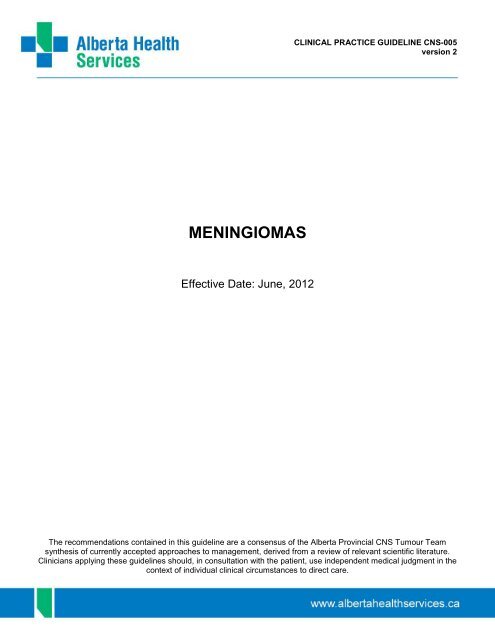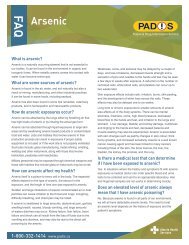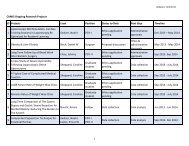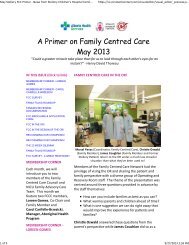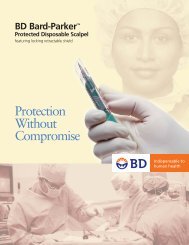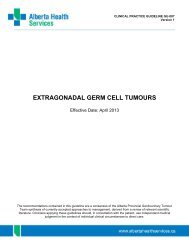Clinical Practice Guideline: Meningioma - Alberta Health Services
Clinical Practice Guideline: Meningioma - Alberta Health Services
Clinical Practice Guideline: Meningioma - Alberta Health Services
You also want an ePaper? Increase the reach of your titles
YUMPU automatically turns print PDFs into web optimized ePapers that Google loves.
CLINICAL PRACTICE GUIDELINE CNS-005<br />
version 2<br />
MENINGIOMAS<br />
Effective Date: June, 2012<br />
The recommendations contained in this guideline are a consensus of the <strong>Alberta</strong> Provincial CNS Tumour Team<br />
synthesis of currently accepted approaches to management, derived from a review of relevant scientific literature.<br />
Clinicians applying these guidelines should, in consultation with the patient, use independent medical judgment in the<br />
context of individual clinical circumstances to direct care.
CLINICAL PRACTICE GUIDELINE CNS-005<br />
version 2<br />
BACKGROUND<br />
By the end of 2012, it is estimated that 2800 new cases of central nervous system (CNS) tumours will be<br />
diagnosed in Canada, and 1850 deaths from CNS tumours will occur during the same period. 1<br />
<strong>Meningioma</strong>s arise from the dural covering of the brain, and are estimated to account for 13 to 26 percent<br />
of all primary brain tumours, making them the second most common intracranial tumours reported in<br />
adults. 2-4 These typically slow-growing tumours occur most frequently after the fifth decade of life, and<br />
affect women almost twice as often as men. 5 <strong>Clinical</strong>ly, meningiomas present with symptoms causing focal<br />
or generalized seizure disorders, focal neurological deficits, or neuropsychological decline; though many<br />
asymptomatic meningiomas are only discovered incidentally during a CT or MRI scan for unrelated<br />
symptoms. 5,6<br />
The World <strong>Health</strong> Organization (WHO) classification system divides meningiomas into three grades based<br />
on histological and pathological characteristics: 7 grade I meningiomas account for as many as 90 percent<br />
of all cases, and are typically benign, grade II or atypical meningiomas account for 5 to 7 percent of cases,<br />
and grade III or anaplastic meningiomas account for 1 to 3 percent of cases. 3,5,7 The development of highgrade<br />
meningiomas has been correlated with exposure to ionizing radiation: the majority of patients with<br />
radiation-induced meningiomas either have a history of low-dose radiation to the scalp for tinea capitis, or<br />
received high-dose radiation for primary brain tumours between 20 and 35 years previous. 8,9<br />
The management of a patient with a meningioma will depend on the signs and symptoms produced by the<br />
tumour, the age of the patient, and location and size of the tumour. 5<br />
GUIDELINE QUESTIONS<br />
• What is the optimal treatment for adult patients with low-grade (WHO grade I) meningiomas?<br />
• What are the optimal treatment strategies for adult patients with atypical (WHO grade II) and<br />
anaplastic (WHO grade III) meningiomas?<br />
DEVELOPMENT AND REVISION HISTORY<br />
This guideline was reviewed and endorsed by the <strong>Alberta</strong> Provincial CNS Tumour Team. Members of the<br />
<strong>Alberta</strong> Provincial CNS Tumour Team include medical oncologists, radiation oncologists, neurosurgeons,<br />
neurologists, nurses, neuropathologists, and pharmacists. Evidence was selected and reviewed by a<br />
working group comprised of members from the <strong>Alberta</strong> Provincial CNS Tumour Team and a Knowledge<br />
Management Specialist from the <strong>Guideline</strong> Utilization Resource Unit. A detailed description of the<br />
methodology followed during the guideline development process can be found in the <strong>Guideline</strong> Utilization<br />
Resource Unit Handbook.<br />
This guideline was originally developed in November, 2009 and was updated in June, 2012.<br />
SEARCH STRATEGY<br />
For the 2012 update of this guideline, medical journal articles were searched using the Medline (2009 to<br />
June 18, 2012), EMBASE (2009 to June 18, 2012), the Cochrane Database of Systematic Reviews (2 nd<br />
Quarter, 2012), and PubMed electronic databases; the references and bibliographies of articles identified<br />
through these searches were scanned for additional sources. The search terms included: <strong>Meningioma</strong><br />
[MeSH heading], Meningeal Neoplasms [MeSH heading], practice guidelines, systematic reviews, metaanalyses,<br />
randomized controlled trials, and clinical trials. Articles were excluded from the review if they:<br />
Page 2 of 7
CLINICAL PRACTICE GUIDELINE CNS-005<br />
version 2<br />
had a non-English abstract, were not available through the library system, were case studies involving less<br />
than 5 patients, or were published prior to the year 2009. A review of the relevant existing practice<br />
guidelines for meningiomas was also conducted by accessing the practice guidelines on the websites of<br />
the British Columbia Cancer Agency (BCCA), the National Institute for <strong>Health</strong> and <strong>Clinical</strong> Excellence<br />
(NICE) and the National Comprehensive Cancer Network (NCCN).<br />
TARGET POPULATION<br />
The recommendations outlined in this guideline apply to adults over the age of 18 years. Different<br />
principles may apply to pediatric patients.<br />
RECOMMENDATIONS<br />
WHO Grade I <strong>Meningioma</strong>:<br />
1. Surgery is the primary treatment for patients who are not candidates for management by watch-andwait.<br />
Complete tumour resection is associated with high rates of disease-free survival.<br />
2. Radiotherapy may be considered in the cases of a tumour location not amenable to surgery (such as a<br />
cavernous sinus meningioma), an unresectable tumour, symptomatic residual disease, or a recurrent<br />
tumour. Radiological diagnosis may be sufficient in these cases.<br />
WHO Grades II and III <strong>Meningioma</strong>s:<br />
3. Standard treatment is surgery plus radiotherapy. Radiotherapy is usually delivered at a dose of 54 to<br />
60 Gy, in 1.8 to 2.0 Gy per fraction.<br />
4. Patients with select tumours may be candidates for stereotactic radiosurgery.<br />
5. Other systemic therapies may be considered for unresectable or recurrent tumours on a clinical trial<br />
basis.<br />
DISCUSSION<br />
WHO Grade I <strong>Meningioma</strong><br />
The <strong>Alberta</strong> Provincial CNS Tumour Team has adopted the recommendations of NICE which state that<br />
surgery is the primary therapy for patients who are not candidates for management by a watch-and-wait<br />
approach (recommendation #1). 10 Small, asymptomatic, benign-appearing meningiomas that are found<br />
during a radiographic evaluation are often followed without therapy, using CT and/or MRI imaging at<br />
regular intervals. 11 Yano et al. recently published a large retrospective series involving 603 patients with<br />
asymptomatic meningiomas and 831 patients with symptomatic ones who were seen between 1989 and<br />
2003 in Japan. 12 Among the 67 asymptomatic patients who were followed for the entire five year follow-up<br />
period, 63 percent did not exhibit tumour growth. Morbidity rates for the asymptomatic patients who were<br />
treated surgically were 4.4 percent for patients younger than 70 years of age and 9.4 percent in patients<br />
over the age of 70. 12 The authors concluded that, since a large proportion of asymptomatic patients will not<br />
become symptomatic in the short-term, active surveillance is an acceptable and recommended approach<br />
for asymptomatic patients with low-grade meningiomas. 12<br />
For patients with surgically accessible tumours, surgical intervention is recommended when the tumour<br />
begins to cause symptoms, or when it displays significant growth on consecutive CT or MRI images. 11 The<br />
completeness of surgical removal is the most important prognostic factor for grade I meningiomas. In a<br />
Page 3 of 7
CLINICAL PRACTICE GUIDELINE CNS-005<br />
version 2<br />
classic study of 145 patients with meningiomas who underwent gross total resection, Miramanoff et al.<br />
reported disease-free survival rates of 93 percent at five years, 80 percent at 10 years, and 68 percent at<br />
fifteen years. 13 Patients who underwent partial resection had significantly lower disease-free survival rates<br />
in this study: 63 percent at five years, 45 percent at ten years, and only 9 percent at fifteen years. 13<br />
Similarly, in a more recent large series involving 581 patients with grade I meningiomas seen at the Mayo<br />
Clinic between 1978 and 1988, Stafford et al. reported disease-free survival rates of 88 percent at five<br />
years and 75 percent at ten years for completed resected patients, while those rates decreased to 61<br />
percent at five years and 39 percent at ten years for the partially resected patients. 14<br />
Gross total resection should always be the goal of surgery, and offers the best possibility of a cure for lowgrade<br />
meningiomas. However, some meningeal tumours, particularly those involving the cavernous sinus,<br />
petroclival region, posterior aspect of the superior sagittal sinus, or optic nerve sheath, cannot be<br />
completely removed due to their relationship to vital neural or vascular structures. 5 For incompletely<br />
resected or recurrent symptomatic grade I meningiomas, the <strong>Alberta</strong> Provincial CNS Tumour Team<br />
recommends the use of radiotherapy (recommendation #2). In observational studies, external beam<br />
radiotherapy (EBRT) has been shown to decrease recurrence rates in patients with incompletely resected<br />
low-grade meningiomas. Rogers et al. recently conducted a comprehensive review of 23 studies published<br />
during a 24 year period involving 2971 patients treated with either gross total resection alone, partial<br />
resection alone, or partial resection plus adjuvant EBRT. 15 Five-year progression-free survival rates<br />
ranged from 77 to 98 percent for the completely resected patients, 43 to 63 percent for the partially<br />
resected patients who did not receive EBRT, and 80 to 100 percent for the partially resected patients who<br />
received adjuvant EBRT. 15 The <strong>Alberta</strong> Provincial CNS Tumour Team recommends doses of adjuvant<br />
EBRT in the range of 50 to 55 Gy in fractions of 1.8 to 2.0 Gy.<br />
WHO Grades II and III <strong>Meningioma</strong>s<br />
Because high-grade meningiomas are associated with high rates of postsurgical recurrence, the standard<br />
treatment for patients with WHO grades II or III meningiomas is surgery followed by post-operative<br />
radiotherapy (recommendation #3). Although there are no data available from randomized clinical trials,<br />
several retrospective analyses suggest that post-operative radiotherapy is effective in decreasing<br />
recurrence rates for high-grade meningiomas. In a recent review of 119 patients with high-grade<br />
meningiomas who had either complete or incomplete resections and were treated post-operatively with<br />
EBRT, Pasquier et al. reported five- and ten-year disease-free survival rates of 58 and 48 percent,<br />
respectively. 16 Similar progression- and disease-free survival rates have been reported in earlier published<br />
series as well, lending support to the consensus that favours administering EBRT early after surgery for<br />
patients with both completely- and partially-resected high-grade meningiomas. 17-20 For patients with highgrade<br />
meningiomas, the <strong>Alberta</strong> Provincial CNS Tumour Team recommends that post-operative<br />
radiotherapy be delivered at a dose of 54 to 60 Gy, in 1.8 to 2.0 Gy per fraction.<br />
Patients with select tumours may be eligible for stereotactic radiosurgery (SRS), a procedure that utilizes<br />
multiple convergent beams to deliver a single dose of radiation to a discrete treatment area, thereby<br />
minimizing injury to surrounding structures (recommendation #4). This technique is most often used for<br />
patients who have small-to-medium sized meningiomas, have tumours that are surgically inaccessible, are<br />
not candidates for surgery, or have residual or recurrent tumours following surgery. 5,11,15,21 In a<br />
retrospective analysis of 127 patients with meningiomas, Hakim et al. reported one-year overall survival<br />
rates of 91.7 percent for the 26 patients with grade II tumours treated with SRS, and 92.3 percent for the<br />
18 patients with grade III tumours treated with SRS. 22 At four years, the overall survival rates were 83.3<br />
percent for grade II and 21.5 percent for grade III tumours. The median marginal tumour dose in this study<br />
Page 4 of 7
CLINICAL PRACTICE GUIDELINE CNS-005<br />
version 2<br />
was 15 Gy (range 9-20 Gy). In a more recent study involving retrospective analysis of 18 patients with<br />
grade II and 12 patients with grade III meningiomas, Harris et al. reported five-year progression-free<br />
survival rates of 83 and 72 percent for grades II and III, respectively. 23 The median marginal tumour dose<br />
for the grade II meningiomas was 14.9 Gy, with a median maximal dose of 29.4 Gy; for grade III<br />
meningiomas, the median marginal tumour dose was 15.7 Gy, with a median maximal dose of 31.4 Gy. In<br />
both the Hakim et al. study and the Harris et al. study, minimal adverse events were reported.<br />
In cases where the tumour is unresectable or all other therapies have failed to prevent a recurrence,<br />
systemic treatment may be considered on a clinical trial basis (recommendation #5). There is only limited<br />
data available on the use of systemic agents in the treatment of meningiomas, and to date, no randomized<br />
controlled studies have been published. The anti-progesterone agent mifepristone has been linked to the<br />
treatment of meningiomas because of epidemiological and biochemical data suggesting that meningioma<br />
growth is hormone-dependent. 24 To date, limited data suggest only moderate improvements in tumour<br />
size. 25-27 The use of hydroxyurea, which is an oral chemotherapeutic agent, has also been associated with<br />
moderate tumour volume reduction and periods of stable disease in studies involving a limited number of<br />
patients. 28-31<br />
GLOSSARY OF ABBREVIATIONS<br />
Acronym<br />
CNS<br />
CT<br />
EBRT<br />
MRI<br />
NICE<br />
SRS<br />
WHO<br />
Description<br />
central nervous system<br />
computed tomography scan<br />
external beam radiotherapy<br />
magnetic resonance imaging<br />
National Institute for <strong>Health</strong> and <strong>Clinical</strong> Excellence<br />
stereotactic radiosurgery<br />
World <strong>Health</strong> Organization<br />
DISSEMINATION<br />
• Present the guideline at the local and provincial tumour team meetings and weekly rounds.<br />
• Post the guideline on the <strong>Alberta</strong> <strong>Health</strong> <strong>Services</strong> website.<br />
• Send an electronic notification of the new guideline to all members of <strong>Alberta</strong> <strong>Health</strong> <strong>Services</strong>, Cancer<br />
Care.<br />
MAINTENANCE<br />
A formal review of the guideline will be conducted at the Annual Provincial Meeting in 2013. If critical new<br />
evidence is brought forward before that time, however, the guideline working group members will revise<br />
and update the document accordingly.<br />
CONFLICT OF INTEREST<br />
Participation of members of the <strong>Alberta</strong> Provincial CNS Tumour Team in the development of this guideline<br />
has been voluntary and the authors have not been remunerated for their contributions. There was no<br />
direct industry involvement in the development or dissemination of this guideline. <strong>Alberta</strong> <strong>Health</strong> <strong>Services</strong><br />
– Cancer Care recognizes that although industry support of research, education and other areas is<br />
necessary in order to advance patient care, such support may lead to potential conflicts of interest. Some<br />
members of the <strong>Alberta</strong> Provincial CNS Tumour Team are involved in research funded by industry or have<br />
Page 5 of 7
CLINICAL PRACTICE GUIDELINE CNS-005<br />
version 2<br />
other such potential conflicts of interest. However the developers of this guideline are satisfied it was<br />
developed in an unbiased manner.<br />
REFERENCES<br />
1. Canadian Cancer Society's Steering Committee on Cancer Statistics. Canadian Cancer Statistics 2012.<br />
Canadian Cancer Society 2012(ISSN 0835-2976).<br />
2. Surawicz TS, McCarthy BJ, Kupelian V, Jukich PJ, Bruner JM, Davis FG. Descriptive epidemiology of primary<br />
brain and CNS tumors: results from the Central Brain Tumor Registry of the United States, 1990-1994. Neuro<br />
Oncol 1999 Jan;1(1):14-25.<br />
3. Claus EB, Bondy ML, Schildkraut JM, Wiemels JL, Wrensch M, Black PM. Epidemiology of intracranial<br />
meningioma. Neurosurgery 2005 Dec;57(6):1088-95; discussion 1088-95.<br />
4. Bondy M, Ligon BL. Epidemiology and etiology of intracranial meningiomas: a review. J Neurooncol 1996<br />
Sep;29(3):197-205.<br />
5. Whittle IR, Smith C, Navoo P, Collie D. <strong>Meningioma</strong>s. Lancet 2004 May 8;363(9420):1535-1543.<br />
6. Nakamura M, Roser F, Michel J, Jacobs C, Samii M. The natural history of incidental meningiomas.<br />
Neurosurgery 2003 Jul;53(1):62-70; discussion 70-1.<br />
7. Louis DN, Ohgaki H, Wiestler OD, Cavenee WK, Burger PC, Jouvet A, et al. The 2007 WHO classification of<br />
tumours of the central nervous system. Acta Neuropathol 2007 Aug;114(2):97-109.<br />
8. Gosztonyi G, Slowik F, Pasztor E. Intracranial meningiomas developing at long intervals following low-dose X-ray<br />
irradiation of the head. J Neurooncol 2004 Oct;70(1):59-65.<br />
9. Umansky F, Shoshan Y, Rosenthal G, Fraifeld S, Spektor S. Radiation-induced meningioma. Neurosurg Focus<br />
2008;24(5):E7.<br />
10. National Institute of <strong>Health</strong> and <strong>Clinical</strong> Excellence. Improving outcomes for people with brain and other CNS<br />
tumours: the manual. June 2006; Available at: http://www.nice.org.uk/nicemedia/pdf/CSG_brain_manual.pdf.<br />
Accessed: January 14, 2013.<br />
11. Bohan E, Glass-Macenka D. It's not your "run of the mill" meningioma: characteristics differentiating low-grade<br />
from high-grade meningeal tumors. J Neurosci Nurs 2009 Jun;41(3):124-8; quiz 129-30.<br />
12. Yano S, Kuratsu J, Kumamoto Brain Tumor Research Group. Indications for surgery in patients with<br />
asymptomatic meningiomas based on an extensive experience. J Neurosurg 2006 Oct;105(4):538-543.<br />
13. Mirimanoff RO, Dosoretz DE, Linggood RM, Ojemann RG, Martuza RL. <strong>Meningioma</strong>: analysis of recurrence and<br />
progression following neurosurgical resection. J Neurosurg 1985 Jan;62(1):18-24.<br />
14. Stafford SL, Perry A, Suman VJ, Meyer FB, Scheithauer BW, Lohse CM, et al. Primarily resected meningiomas:<br />
outcome and prognostic factors in 581 Mayo Clinic patients, 1978 through 1988. Mayo Clin Proc 1998<br />
Oct;73(10):936-942.<br />
15. Rogers L, Mehta M. Role of radiation therapy in treating intracranial meningiomas. Neurosurg Focus<br />
2007;23(4):E4.<br />
16. Pasquier D, Bijmolt S, Veninga T, Rezvoy N, Villa S, Krengli M, et al. Atypical and malignant meningioma:<br />
outcome and prognostic factors in 119 irradiated patients. A multicenter, retrospective study of the Rare Cancer<br />
Network. Int J Radiat Oncol Biol Phys 2008 Aug 1;71(5):1388-1393.<br />
17. Goldsmith BJ, Wara WM, Wilson CB, Larson DA. Postoperative irradiation for subtotally resected meningiomas.<br />
A retrospective analysis of 140 patients treated from 1967 to 1990. J Neurosurg 1994 Feb;80(2):195-201.<br />
18. Dziuk TW, Woo S, Butler EB, Thornby J, Grossman R, Dennis WS, et al. Malignant meningioma: an indication<br />
for initial aggressive surgery and adjuvant radiotherapy. J Neurooncol 1998 Apr;37(2):177-188.<br />
19. Hug EB, Devries A, Thornton AF, Munzenride JE, Pardo FS, Hedley-Whyte ET, et al. Management of atypical<br />
and malignant meningiomas: role of high-dose, 3D-conformal radiation therapy. J Neurooncol 2000<br />
Jun;48(2):151-160.<br />
20. Milosevic MF, Frost PJ, Laperriere NJ, Wong CS, Simpson WJ. Radiotherapy for atypical or malignant<br />
intracranial meningioma. Int J Radiat Oncol Biol Phys 1996 Mar 1;34(4):817-822.<br />
21. Modha A, Gutin PH. Diagnosis and treatment of atypical and anaplastic meningiomas: a review. Neurosurgery<br />
2005 Sep;57(3):538-50; discussion 538-50.<br />
22. Hakim R, Alexander E,3rd, Loeffler JS, Shrieve DC, Wen P, Fallon MP, et al. Results of linear accelerator-based<br />
radiosurgery for intracranial meningiomas. Neurosurgery 1998 Mar;42(3):446-53; discussion 453-4.<br />
Page 6 of 7
CLINICAL PRACTICE GUIDELINE CNS-005<br />
version 2<br />
23. Harris AE, Lee JY, Omalu B, Flickinger JC, Kondziolka D, Lunsford LD. The effect of radiosurgery during<br />
management of aggressive meningiomas. Surg Neurol 2003 Oct;60(4):298-305; discussion 305.<br />
24. Rockhill J, Mrugala M, Chamberlain MC. Intracranial meningiomas: an overview of diagnosis and treatment.<br />
Neurosurg Focus 2007;23(4):E1.<br />
25. Koide SS. Mifepristone. Auxiliary therapeutic use in cancer and related disorders. J Reprod Med 1998<br />
Jul;43(7):551-560.<br />
26. Grunberg SM, Weiss MH, Spitz IM, Ahmadi J, Sadun A, Russell CA, et al. Treatment of unresectable<br />
meningiomas with the antiprogesterone agent mifepristone. J Neurosurg 1991 Jun;74(6):861-866.<br />
27. de Keizer RJ, Smit JW. Mifepristone treatment in patients with surgically incurable sphenoid-ridge meningioma: a<br />
long-term follow-up. Eye (Lond) 2004 Sep;18(9):954-958.<br />
28. Mason WP, Gentili F, Macdonald DR, Hariharan S, Cruz CR, Abrey LE. Stabilization of disease progression by<br />
hydroxyurea in patients with recurrent or unresectable meningioma. J Neurosurg 2002 Aug;97(2):341-346.<br />
29. Newton HB, Slivka MA, Stevens C. Hydroxyurea chemotherapy for unresectable or residual meningioma. J<br />
Neurooncol 2000 Sep;49(2):165-170.<br />
30. Schrell UM, Rittig MG, Anders M, Koch UH, Marschalek R, Kiesewetter F, et al. Hydroxyurea for treatment of<br />
unresectable and recurrent meningiomas. II. Decrease in the size of meningiomas in patients treated with<br />
hydroxyurea. J Neurosurg 1997 May;86(5):840-844.<br />
31. Reardon DA, Norden AD, Desjardins A, Vredenburgh JJ, Herndon JE,2nd, Coan A, et al. Phase II study of<br />
Gleevec[REGISTERED] plus hydroxyurea (HU) in adults with progressive or recurrent meningioma. J<br />
Neurooncol 2012 Jan;106(2):409-415.<br />
Page 7 of 7


